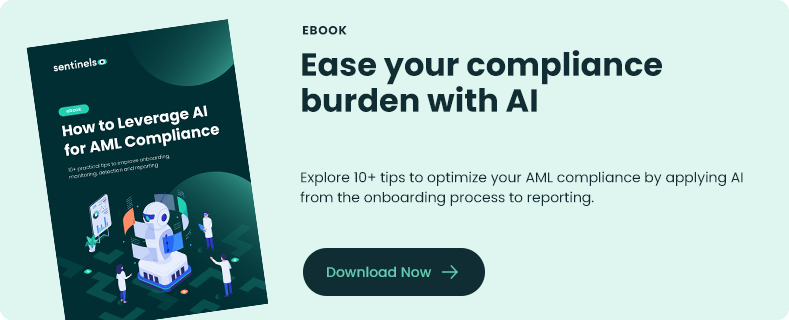On the 13th of October 2020, Sentinels' Managing Director, Joost van Houten discussed the current trends in transaction monitoring, and how our solution improved the AML operations of the latest Dutch fintech unicorn - Mollie.
Deloitte Fintech Webinar - Recap
On the 13th of October 2020, Sentinels' Managing Director, Joost van Houten discussed the current trends in transaction monitoring, and how our solution improved the AML operations of the latest Dutch fintech unicorn - Mollie.
Sentinels
Introduction and the three key points
Deloitte's webinar hosts, Hilko van Rooijen and Stephan Ong, kicked off the webinar with a short introduction of the transaction monitoring landscape, and defined three main trends:
- Increasing attention - coming from regulators and other financial authorities imposing more guidelines and moving their attention to fintechs.
- Advancing technology - the increased adoption of advanced analytics and machine learning in transaction monitoring, and how these advances are also influencing compliance in practice.
- Importance of partnerships - the importance of making the right strategic decisions and partnering with the right provider, and the related trend of data-sharing and a collective approach to transaction monitoring.
Increasing attention
With regulations firmly in place, and new ones being implemented, the financial authorities are including fintechs in the spotlight. Fintech innovators now need to adjust to higher standards to obtain and retain a license to operate legally in the financial sphere. This comes with the responsibility of having an in-house compliance team. It's crucial to have the right processes in place from onboarding to transaction monitoring and from reporting to auditing. What's more, the technology supporting those processes also needs to be fully compliant with the regulations and approved by the relevant authorities.
Advancing technology
Even though the technological advancements in AI and network analysis are the enablers of this trend, it is mainly the regulators themselves pushing for implementing the most effective technology out there. Wisely, international regulators are moving to assess effectiveness of compliance, rather than adherence to processes. Between the guidelines and this trend, you can see an increased need for business intelligence to shape and improve existing AML and compliance processes, with the Dutch National Bank (DNB – Netherlands regulatory authority) clearly pointing to an automated and self-learning infrastructure.
“An institution needs to have an automated and self-learning transaction monitoring system commensurate with its risk profile” - DNB, Post-event transaction monitoring maturity model for payment service providers
The only existing technology that could meet these standards is AI. Even though it is early days, AI has already shown promising results, such as increasing the efficiency of operations and in successfully detecting more suspicious behaviour. AI is also now streamlining ‘rocky’ transaction monitoring measurements.
“Structural use of pattern recognition and network analysis to recognize unusual transactions” - DNB, Post-event transaction monitoring maturity model for payment service providers
A closer look at compliance in practice
After discussing the trends influencing the transaction monitoring landscape and theregulators, Deloitte outlined the essentials of compliance in practice:
The governance:
It starts with understanding your own business and establishing clear risk assessment policies (SIRA). These form the basis for traditional financial institutions and fintechs to establish their compliance processes and governance.
Onboarding, risk assessment and CDD:
From the SIRA, processes are established, starting at onboarding and collecting the essential information from their client and making a risk assessment. After the initial validation, ongoing monitoring of the client’s transactional behaviour and in case of detected suspicious behaviour, deeper investigation and reporting follows.
The supporting tools:
Technology helps compliance and risk teams manage the whole process, from KYC and CDD to transaction monitoring. It is key to find solutions that can not only streamline the whole process but also be more efficient in detection. And when required, the solution must easily report cases to the relevant authorities.
Growing partnerships
The new regulations combined with the challenge to remain compliant do not just affect the larger more traditional financial institutions. These issues also significantly impact the smaller innovative players. When Mollie reached its exponential growth phase, they needed to streamline all their processes, including risk and compliance. Their aim was to improve both the onboarding and transaction monitoring in such a way that it was sustainable.
Mollie conducted an in-depth RFP, reviewing ten incumbents in the transaction monitoring space. Their thorough analysis revealed that most of the existing solutions were not build for agile (PSP) innovators. Mollie holds their vendors to the same high standards as their own product development, and they are known for their "Apple and Star Wars mindset".
Slimmer AI's machine learning-first approach matched with Mollie's vision. A partnership was formed, and with more than sixty “Jedi” engineers and ten years of experience with applied AI product development, Slimmer AI was ready to combat the dark force and establish an innovative transaction monitoring product (now known as Sentinels). One of Slimmer AI's core values is a strong belief in like-minded partnerships. "We grow as you grow" was exactly what the next biggest payments unicorn was looking for.
The Sentinels difference
Sentinels' AI-powered stack for transaction monitoring allows using different internal and external data sources to teach the algorithm to spot patterns humans alone would normally miss. As a result, Mollie has a better understanding of their customer data and potential risks. Working closely with Mollie's risk & compliance team, Slimmer AI has improved Mollie’s business rules performance. We achieved this by gradually replacing underperforming business rules with machine learning. This pragmatic machine learning approach has helped reduce false-positive rates of initially low performing business rules from 96% to 75%. Based on the compliance team's feedback and the regulators' requirements to frequently update business rules, we've made them editable from the Sentinels user interface. Developer time is no longer needed, and compliance officers can update the rules themselves.
Sentinels transaction monitoring goes beyond simple automation. The Sentinels Network Analysis feature, for example, helps Mollie to detect suspicious behaviour sooner and aids in accelerating investigations. The Network Analysis feature reveals connections between different clients that are less likely to trigger alerts individually, but when looking collectively, reveals suspicious patterns.
We also paid close attention to technology usability and experience. By incorporating the newest UX and UI trends into our interface, Sentinels has managed to reduce workload by 50% while simultaneously improving investigation quality.
Lessons learned
The partnership between Mollie and Slimmer AI’s Sentinels has led to insightful learnings. For example, we both noticed that it was important to nurture both internal compliance processes and as well as the transaction monitoring solution itself. Mollie had to face the critical question that now all financial institutions must answer when it comes to compliance: “Should we build the solution in-house or outsource it to a third-party provider?”. As everyone knows, building technology inhouse is always challenging. But this challenge is even more compounded when the solution is not the core of your business and increasingly requires expert knowledge in advanced technologies such as AI and ML. The financial institutions which choose to buy over build, they must ensure needed safeguards to combat the fear of "losing control" over part of your operations. It is therefore key to find an agile partner you trust.
Vision for the future
We concluded the conversation by defining a clear and increasing need for AI and ML in the future of AML compliance. With the flexibility of Open Banking and PSD2 and initiatives like TMNL to outsource transaction monitoring, financial institutions are now able to thoughtfully consider and embrace the right partnerships. As a result, we will see more and more, future-focused PSPs like Mollie choosing to partner with like-minded AI innovators like Sentinels.






